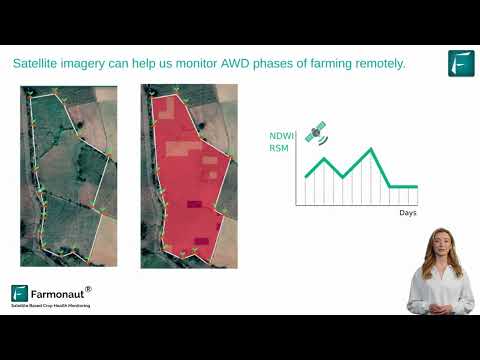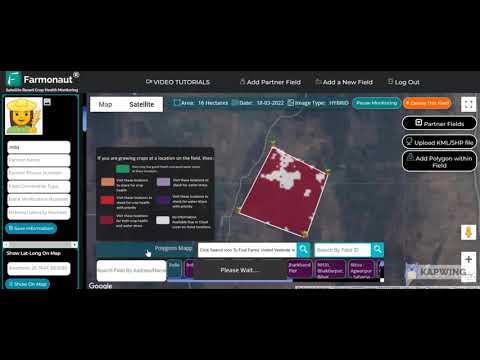Farmonaut’s Guide: Navigating the 2022 Emergency Relief Program for Farmers Impacted by Natural Disasters

“The 2022 Emergency Relief Program offers two distinct tracks for farmers to apply for disaster assistance.”
Welcome to Farmonaut’s comprehensive guide on the 2022 Emergency Relief Program (ERP) for farmers impacted by natural disasters. As experts in agricultural technology and advocates for sustainable farming practices, we understand the critical importance of disaster relief in maintaining a resilient agricultural sector. In this blog post, we’ll explore how the United States Department of Agriculture (USDA) and Farm Service Agency (FSA) programs are supporting farmers and ranchers through challenging times.
At Farmonaut, we’re committed to empowering farmers with cutting-edge satellite-based farm management solutions. While our focus is on providing advanced crop monitoring and AI-driven advisory services, we recognize the vital role that government assistance plays in agricultural disaster recovery. Let’s delve into the details of the ERP and how it’s shaping the future of agricultural disaster preparedness and recovery.
Understanding the 2022 Emergency Relief Program
The Emergency Relief Program is a crucial USDA initiative designed to provide vital funding for producers impacted by natural disasters. This program offers crop disaster assistance and agricultural disaster recovery support to help farmers and ranchers navigate the challenges of weather-related crop losses and livestock relief.
Key aspects of the ERP include:
- Assistance for losses due to drought, wildfires, hurricanes, and other qualifying natural disaster events
- Integration with crop insurance and Non-insured Crop Disaster Assistance Program (NAP) for comprehensive coverage
- Two distinct application tracks to accommodate different producer situations
- Focus on promoting sustainability in agriculture and supporting underserved producers
ERP Eligibility Requirements
To qualify for the Emergency Relief Program, producers must meet specific criteria set by the USDA. These requirements ensure that assistance reaches those most affected by natural disasters:
- Experienced qualifying losses due to eligible natural disaster events in 2020 and 2021
- Had eligible crops insured through Federal Crop Insurance or NAP coverage
- Meet conservation compliance provisions
- Not exceed certain adjusted gross income limitations
It’s important to note that eligibility may vary depending on the specific track of the program. We’ll explore these tracks in more detail later in this guide.
Types of Natural Disasters Covered
The ERP provides assistance for a wide range of natural disasters that can significantly impact agricultural operations. These include:
- Drought
- Wildfires
- Hurricanes
- Floods
- Derechos
- Excessive heat
- Winter storms
- Freeze (including a polar vortex)
- Smoke exposure
- Excessive moisture
- Qualifying disaster events that occurred in 2020 and 2021
Understanding which disasters are covered is crucial for farmers and ranchers when assessing their eligibility for relief.
ERP Disaster Relief Comparison Table
| Disaster Type | Estimated Average Crop Loss (%) | Typical ERP Payment Range ($) | Required Documentation | Application Deadline |
|---|---|---|---|---|
| Drought | 30-50% | $10,000 – $100,000 | Crop insurance records, FSA-578 | 60 days from FSA notification |
| Wildfire | 70-100% | $50,000 – $250,000 | Fire incident report, crop loss assessment | 60 days from FSA notification |
| Hurricane | 50-80% | $25,000 – $200,000 | Weather reports, damage assessment photos | 60 days from FSA notification |
| Flood | 40-60% | $15,000 – $150,000 | Flood maps, crop damage reports | 60 days from FSA notification |
| Winter Storm | 20-40% | $5,000 – $75,000 | Weather data, livestock loss documentation | 60 days from FSA notification |
This table provides a quick overview of how different natural disasters are addressed by the ERP. It’s important to note that actual losses and payment amounts may vary based on individual circumstances and program specifics.
The Two Tracks of ERP
The Emergency Relief Program is structured into two distinct tracks to accommodate different producer situations:
Track One (ERP Phase One)
This track is for producers who participated in eligible crop insurance or NAP programs. Key points include:
- Streamlined application process
- Pre-filled applications based on existing crop insurance or NAP data
- Faster payment delivery for many producers
Track Two (ERP Phase Two)
This track is designed for producers who did not participate in crop insurance or NAP, or certain producers with crop insurance coverage under Whole-Farm Revenue Protection. Features include:
- More complex application process
- Requires additional documentation from producers
- Aims to fill gaps in disaster assistance
Understanding which track applies to your situation is crucial for navigating the application process effectively.
Application Process and Documentation
The application process for the Emergency Relief Program varies depending on which track you’re eligible for. Here’s a general overview:
Track One Application:
- Receive pre-filled application form from FSA
- Review and verify the information
- Complete and sign form FSA-520
- Return the form to your local FSA office
Track Two Application:
- Contact your local FSA office
- Gather required documentation (may include production records, sales receipts, tax returns)
- Complete application forms as directed by FSA
- Submit all required materials before the deadline
Regardless of the track, it’s crucial to maintain thorough records and respond promptly to any FSA requests for additional information.
Payment Calculations and Distribution
ERP payments are calculated based on several factors, including:
- Type and level of crop insurance coverage
- Verified crop losses
- Adjusted Gross Income (AGI) limitations
- Payment limitation caps
The USDA uses a complex formula to determine payment amounts, which may include factors such as:
- Expected value of the crop
- Actual value of the crop harvested
- Amount of insurance indemnity received
- Applicable payment factors based on coverage level
Payments are typically distributed in phases, with initial payments often capped at a certain percentage of the calculated total to ensure fund availability for all eligible producers.

“USDA’s ERP integrates with crop insurance and NAP to provide comprehensive coverage for weather-related agricultural losses.”
Integration with Crop Insurance and NAP
The Emergency Relief Program is designed to work in conjunction with existing crop insurance and Non-insured Crop Disaster Assistance Program (NAP) coverage. This integration ensures comprehensive protection for producers against weather-related losses. Here’s how it works:
- ERP supplements rather than replaces crop insurance or NAP payments
- Producers with crop insurance or NAP coverage may receive additional assistance through ERP
- The program takes into account indemnities received from crop insurance or NAP when calculating ERP payments
This integrated approach helps to fill gaps in coverage and provide more robust support for farmers and ranchers facing natural disasters.
Supporting Underserved Producers
The USDA has made a concerted effort to ensure that the Emergency Relief Program reaches underserved producers. This includes:
- Socially disadvantaged farmers and ranchers
- Beginning farmers
- Limited resource producers
- Veteran farmers and ranchers
Specific provisions within the ERP aim to increase accessibility and support for these groups, such as:
- Targeted outreach and education efforts
- Assistance with application processes
- Potential for increased payment rates in some cases
These efforts align with broader USDA initiatives to promote equity and inclusivity in agricultural programs.
Impact on Agricultural Sustainability
While the primary goal of the Emergency Relief Program is to provide immediate assistance to producers affected by natural disasters, it also plays a role in promoting long-term agricultural sustainability. Here’s how:
- Encourages adoption of resilient farming practices
- Supports the continuation of farming operations in the face of climate challenges
- Helps maintain food security by stabilizing agricultural production
- Promotes conservation efforts through program requirements
By providing this crucial support, the ERP contributes to the overall resilience and sustainability of the agricultural sector.
Challenges and Considerations
While the Emergency Relief Program offers significant benefits, there are some challenges and considerations that producers should be aware of:
- Complex application processes, especially for Track Two
- Potential delays in payment distribution
- Need for accurate record-keeping and documentation
- Limitations on payment amounts and eligibility criteria
It’s important for producers to carefully review program details and seek assistance from FSA offices or agricultural advisors when needed.
Future of Agricultural Disaster Preparedness
The implementation of the Emergency Relief Program reflects a growing recognition of the need for robust disaster preparedness in agriculture. Looking ahead, we can expect to see:
- Continued evolution of disaster relief programs
- Increased focus on climate resilience in agricultural policies
- Integration of advanced technologies for risk assessment and mitigation
- Enhanced coordination between federal, state, and local disaster response efforts
At Farmonaut, we’re committed to supporting these efforts through our advanced satellite-based farm management solutions. Our technology can help farmers better prepare for and respond to natural disasters by providing real-time crop health monitoring and AI-driven insights.
How Farmonaut Supports Disaster Preparedness
While Farmonaut is not directly involved in the implementation of government disaster relief programs, our technology plays a crucial role in helping farmers prepare for and mitigate the impacts of natural disasters:
- Real-time crop health monitoring using satellite imagery
- AI-powered advisory systems for optimized crop management
- Weather forecasting and alerts to help farmers prepare for potential disasters
- Data-driven insights to support informed decision-making
By leveraging these tools, farmers can enhance their resilience to natural disasters and potentially reduce the severity of crop losses.
Explore Farmonaut’s advanced agricultural solutions:
For developers interested in integrating our satellite and weather data into their own systems, check out our API and API Developer Docs.
Frequently Asked Questions
- Q: Who is eligible for the Emergency Relief Program?
A: Producers who suffered losses due to qualifying natural disaster events in 2020 and 2021, and who had eligible crops insured through Federal Crop Insurance or NAP coverage are generally eligible. - Q: How do I apply for ERP assistance?
A: The application process depends on whether you qualify for Track One or Track Two. Track One applicants will receive pre-filled applications from FSA, while Track Two applicants need to contact their local FSA office to begin the process. - Q: What documents do I need to apply?
A: Required documentation may include crop insurance records, FSA-578 forms, production records, sales receipts, and tax returns, depending on your specific situation and which track you’re applying under. - Q: Is there a deadline for applying?
A: Yes, deadlines are typically set for each phase of the program. For most applicants, the deadline is 60 days from receiving notification from FSA. It’s crucial to submit applications as soon as possible. - Q: How are ERP payments calculated?
A: Payments are calculated based on factors including the type and level of crop insurance coverage, verified crop losses, and applicable payment limitations. The USDA uses a complex formula that considers the expected value of the crop, actual value harvested, and insurance indemnities received.
Conclusion
The 2022 Emergency Relief Program represents a significant effort by the USDA to support farmers and ranchers impacted by natural disasters. By providing crucial financial assistance and integrating with existing crop insurance and NAP programs, the ERP plays a vital role in agricultural disaster recovery and promotes long-term sustainability in the face of climate challenges.
As we navigate the complexities of modern agriculture, programs like the ERP, combined with advanced technologies such as those offered by Farmonaut, form a comprehensive approach to disaster preparedness and recovery. We encourage all eligible producers to explore the benefits of the Emergency Relief Program and to consider how technology-driven solutions can enhance their farm management practices.
For more information on how Farmonaut’s satellite-based farm management solutions can help you optimize your agricultural operations and build resilience against natural disasters, visit our website or download our mobile app today.
Additional Resources
To stay informed about agricultural disaster relief programs and advanced farming technologies, consider exploring these resources:
- USDA Farm Service Agency website for the latest updates on disaster assistance programs
- Local FSA offices for personalized guidance on program eligibility and application processes
- Agricultural extension services for education on resilient farming practices
- Farmonaut’s blog and resources for insights on precision agriculture and satellite-based farm management
By staying informed and leveraging available resources, farmers and ranchers can better position themselves to withstand and recover from natural disasters, ensuring the continued strength and resilience of American agriculture.







